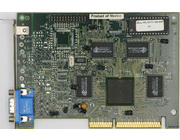When the RIVA 128ZX came to market, nVidia wasn't that well established in the 2D/3D market yet. They already had the NV1-chip (used in the Diamond Edge 3D cards) with 3D-features, sound and an interface for SEGA Saturn controllers but that wasn't a great succes. The NV2 was to be designed for SEGA but still based on NV1. NV2 was cancelled and nVidia went on for NV3: the RIVA 128.
nVidia made great effort in designing a 2D/3D chip and had to compete with the 3Dfx Voodoo2. nVidia opted to design with Direct3D in mind. They also used a unified memory architecture and used, the then new, AGP2x interface. What I've read from back in the day: nVidia had problems supporting Direct3D and OpenGL and suffered from several driver problems. Most of them were solved over time but apparently games like Unreal never ran properly on the RIVA 128.
I never used the RIVA 128 myself so I'm just writing what others have experienced. When I assemble my benchmark system for the RIVA 128 (and other cards from the generation) I'll benchmark with the latest drivers but also go back in time to test a few earlier drivers and see what the fuss is all about ![]() .
.
RIVA stands for Real-time Interactive Video and Animation accelerator. The ZX is the improved version that runs at a higher clock-frequency and is able run in 8MB configurations as well. The original RIVA 128 is limited to 4MB. > Read more
This Diamond Viper V330 uses an nVidia RIVA 128 chipset. The RIVA 128 (NV3) was released in late 1997 as successor of the NV1 and combined 2D and 3D in one chip. RIVA stands for Real-time Interactive Video and Animation accelerator.
In end of 1997, 3Dfx already established a name in the 3D market with the Voodoo Graphics card. This Direct3D 5.0-capable card from nVidia was directly compared with the Voodoo Graphics. Performance, image quality and drivers were discussed. As far as I'm aware of the Voodoo Graphics was more popular as no-one in my area started talking about nVidia until the Riva TNT made its debut. > Read more



